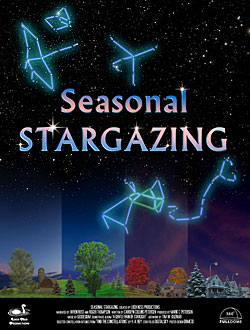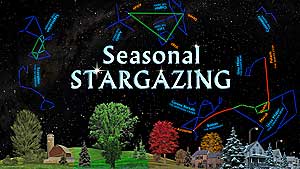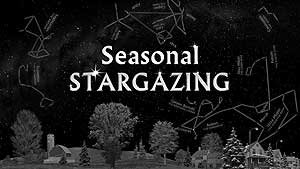Seasonal STARGAZING
Night Sky star talks — rendered in fulldome video!
16 star shows — at the push of a button!
Offer consistent, reliable star identification shows with any level of staffing!
Star talks are the quintessential planetarium presentation, the bread and butter of a star theater's repertoire. Since many people come to the planetarium specifically for the "what's up in the night sky" presentation, now you can always have a dependable one on tap! The advent of fulldome video technology has allowed us to create Seasonal STARGAZING, an extremely versatile set of star shows — at an extremely reasonable price. You get 16 ways to show "what's up!"
Each Seasonal STARGAZING show highlights the most prominent and easy-to-find stars and constellations of the season. We've upgraded the old standby green-arrow show, painting the dome with choreographed circles and colorful constellation lines. Audience members see and hear star names and constellations, and learn to star-hop for popular deep-sky objects.
They're a great start on stargazing for audiences of all ages!
An Incredible Package
* A set of 4 MINI and 4 FULL length shows? That's Eight! Wait, it gets better.
* We produced the set of eight seasonal MINI and FULL shows twice, with both male and female narrators, for a total of 16 shows!
* 16 shows — why, that's nearly 3 hours of fulldome programming! All in one convenient, ready-to-play package.
* No gate shares, no attendance reports, no "large-capacity theater" price penalty. Just a 20-year license to run these shows as much as you want in your dome. (Our standard performance license agreement spells out the details.)
A Winning Formula
Each show is structured the same way:
* We start out under the starry sky and a little Geodesium night music to get people in the mood for stargazing.
* After a short introduction, we do some stargazing from a typical "suburban/city" locale, with some light pollution for added sky realism. First we look north for the Big Dipper and Polaris and other prominent stars and constellations.
* Then we rotate the sky to the south, to look for the season's easy-to-find patterns in that half of the sky.
* At this point, the MINI versions wrap up and close; the FULL versions continue, taking audiences out to the country for some dark-sky viewing (rotating back to north during the transition).
* From the north-facing countryside, we revisit the bright stars and constellations we saw in the city.
* Then we turn to the south once again, point out the Milky Way if it's not low on the horizon, and locate some easy naked-eye deep-sky objects, such as the Andromeda Galaxy or the Orion Nebula, along the way.
* And every show ends with some encouraging words: "The more you look at the night sky, the more you'll find. And all you have to do is go outside — and look up! Try it tonight!"
Each Season Has Two Lengths To Fit Your Needs
Every theater has different time requirements. Some want shorter shows, others use longer ones. Some teachers like modules to plug into specific lessons in the dome curricula. It seemed to us we could give everybody what they need by designing the shows to offer both MINI and FULL versions, averaging 7 and 14 minutes respectively, and they are all included in the package. It's win-win all the way around!
Two Voices, More Choices
The days of debating "which voice is better, male or female" are long behind us. The quality of a professional presentation transcends gender. But while an audience may experience a show only once, it's the show presenters who hear the soundtracks day after day, and end up memorizing lines and recalling entire shows verbatim years later. So, with a choice of two voices, you can help relieve console operator fatigue! Use the female voice for the winter and summer, and the male for spring and autumn. Or, alternate male/female each week! Or, use only male or only female all the time. It's up to you; you have the options. Find out more about our narrators.
But Will They Work In Your Theater?
These are Northern Hemisphere shows. The skies are depicted from 40° North latitude. That's close to where much of the world's planetarium-going population is. Most of the featured objects in our shows are prominent in their seasonal sky, and visible from latitudes well above and below 40°. Here's a full listing of what's in each show.
The shows work with both truncated and full fisheye projector systems. We have optimized them for front-facing audience viewing. No sore necks from straining to see what's upside-down or behind the audience; we "rotate the dome" for you, and put cardinal points on the horizon so everybody knows which way they're looking! Of course you can show them in a concentric-seat theater too.
Our horizon is level, so if you have a tilted dome, the whole sky will be tilted the same angle as your dome. But that's probably the way you do your "what's up tonight" star talks anyway!
You Might Have More Questions...
... so read Seasonal STARGAZING In Depth for more details. And be sure to check out the FAQ; maybe we've answered your question already! If not, simply contact us; we'd be happy to hear from you.
| RUNNING TIMES | MINI | FULL |
|---|---|---|
| Spring | 7:12 | 13:30 |
| Summer | 6:31 | 13:55 |
| Autumn | 6:21 | 13:16 |
| Winter | 7:40 | 14:55 |
Age level: General public
Year of production: 2007
Narrated by Wren Ross and Roger Thompson
Words expertly crafted by Carolyn Collins Petersen
Stereo soundtrack with original music by Geodesium
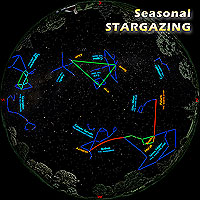 Seasonal STARGAZING provides an educational focus on stars, constellations, star patterns, galaxies, and nebulae, via themes that help relate the information presented in the show to the lives of show attendees.
Seasonal STARGAZING provides an educational focus on stars, constellations, star patterns, galaxies, and nebulae, via themes that help relate the information presented in the show to the lives of show attendees.
The shows are intended for general public audiences and are also useful as introductions to the night sky for students grades 1-12.
For curriculum purposes, the content of the presentations falls under the content standards listed below.
- Objects in the sky
- Stars, constellations, patterns, double stars, clusters, nebulae, galaxies
- Seasonal changes in the sky
- Ever-changing star patterns and reinforcement of pattern-recognition skills
- Positions of objects in the sky: seasonal differences in sky patterns
- Distances to celestial objects and definition of the term light-year
- Systems, order and organization
- Shows discuss stars and their sky positions; star clusters and galaxies presented as large organizations of stars.
- Change, constancy, and measurement
These tables show you when and which objects are featured, and whether they're only in the FULL version.
| Constellations and Asterisms | Spring | Summer | Autumn | Winter |
| Andromeda, the Chained Maiden | Autumn FULL | |||
| Aquila, the Eagle | Summer FULL | Autumn FULL | ||
| Auriga, the Charioteer | Spring FULL | Autumn FULL | Winter | |
| Boötes, the Herdsman | Spring FULL | Summer | ||
| Canis Major, the Greater Dog | Winter FULL | |||
| Canis Minor, the Lesser Dog | Spring FULL | Winter FULL | ||
| Cassiopeia, the Queen | Autumn | Winter | ||
| Coma Berenices, Berenice’s Hair | Spring FULL | |||
| Corona Borealis, the Northern Crown | Spring FULL | Summer FULL | ||
| Corvus, the Crow | Spring FULL | |||
| Cygnus, the Swan | Summer FULL | Autumn FULL | ||
| Delphinus, the Dolphin | Summer FULL | |||
| Gemini, the Twins | Spring FULL | Winter | ||
| Leo, the Lion | Spring | |||
| Lyra, the Harp | Summer FULL | Autumn FULL | ||
| Orion, the Hunter | Winter | |||
| Pegasus, the Winged Horse | Autumn FULL | |||
| Sagittarius, the Archer | Summer FULL | |||
| Scorpius, the Scorpion | Summer FULL | |||
| Taurus, the Bull | Winter | |||
| Ursa Major, the Greater Bear | Spring | Summer | Winter | |
| Ursa Minor, the Lesser Bear | Spring FULL | Summer FULL | Winter FULL | |
| The Belt Of Orion | Winter | |||
| The Big Dipper | Spring | Summer | Autumn | Winter |
| The Great Square of Pegasus | Autumn FULL | |||
| The Little Dipper | Spring FULL | Summer FULL | Autumn FULL | Winter FULL |
| The Northern Cross | Summer | |||
| The Pointers | Spring | Summer | Autumn | Winter |
| The Sickle Of Leo | Spring FULL | |||
| The Summer Triangle | Summer | Autumn | ||
| The Teapot | Summer | |||
| The Winter Circle | Winter |
| Prominent Stars | Spring | Summer | Autumn | Winter |
| Alcor | Spring FULL | Summer FULL | ||
| Aldebaran | Winter | |||
| Altair | Summer | Autumn | ||
| Antares | Summer | |||
| Arcturus | Spring | Summer | ||
| Betelgeuse | Winter | |||
| Capella | Spring | Autumn FULL | Winter | |
| Castor | Spring | Winter | ||
| Deneb | Summer | Autumn | ||
| Denebola | Spring FULL | |||
| Dubhe | Spring | Summer | Autumn | Winter |
| Gemma | Spring FULL | Summer FULL | ||
| Merak | Spring | Summer | Autumn | Winter |
| Mizar | Spring FULL | Summer FULL | ||
| Polaris | Spring | Summer | Autumn | Winter |
| Pollux | Spring | Winter | ||
| Procyon | Spring | Winter | ||
| Regulus | Spring | |||
| Rigel | Winter | |||
| Sirius | Winter | |||
| Spica | Spring | |||
| Vega | Summer | Autumn |
| Deep-sky Objects (FULL only) | Spring | Summer | Autumn | Winter |
| The Andromeda Galaxy | Autumn | Winter | ||
| Coma Berenices constellation / open star cluster | Spring | |||
| The Hyades open star cluster | Winter | |||
| M6 star cluster | Summer | |||
| M7 star cluster | Summer | |||
| The Milky Way | Summer | Autumn | Winter | |
| The Orion Nebula | Winter | |||
| The Pleiades open star cluster | Autumn | Winter |
Here's where we get to share our show philosophy with you, the same way that directors and producers often explain their work on those extended DVD versions of popular movies. Enjoy!
In the beginning...
The original impetus to create these shows came from Garry Beckstrom at the Delta College Planetarium in Bay City, Michigan. He commissioned us to create four seasonal star shows custom-made for his facility, primarily to meet a simple need: he wasn't able to find and train enough staff who would be qualified to present all the shows in their schedule. While pre-recorded star shows may seem anathema to seasoned planetarians who pride themselves on their years of experience presenting "green-arrow" shows, not every show presenter can be on call 24/7... and on top of their game for every audience. Naturally, Garry requested that we include his own star talk favorites and deep-sky objects. After we finished his project, we set out to make "our own" versions.
When we sat down to sketch out the ideas for these seasonal sky shows, we drew not only on our own experiences giving such shows, but the many presentations we've seen (or in some cases, endured) at various planetarium facilities through the years.
We knew we wanted audiences to walk away with the ability to find at least a few of the most prominent stars, constellations, and naked-eye deep-sky objects of the season. And we wanted to provide just the right amount of information and direction in a friendly, approachable way — as if we were standing outside with friends, helping to guide them around the sky.
That's a tall order, when not everyone who comes to the planetarium has the same expectation from their experience. Some people just want to see a nice show. Others want to go out stargazing afterward. Some may want to find out something more about objects they've heard of, like the Orion Nebula or the Andromeda Galaxy. Often, the audience is a school class on a field trip, there to really learn about the stars. Our programs would show to audiences in different places, physically and intellectually — in cities, suburbs, even rural locations; and at all age levels, from grandparents to grandchildren. And they'll show on all kinds of projector systems, in portable domes and large theaters.
Creating shows to bring the skies to everyone, in a friendly, professional manner — we had our work cut out for us.
Starting with Constellations
Most planetarium projectors come with elaborate constellation figures installed. These are almost always based on classical mythology, paying tribute to the way the stars have been woven into our cultural heritage over the centuries. They may be great for star tales, but they're not so wonderful for actually finding things in the sky. When we were growing up, we were always disappointed that we didn't see those gorgeous glowing figures in the real sky. The way we learned the constellations was — like so many others before us — from the books of H. A. Rey, The Stars: A New Way To See Them and Find The Constellations. We always wanted to see Rey's constellation figures used in a planetarium setting, and now we have. One more childhood dream realized!
In our shows, there's no guessing about how to visualize the constellation patterns. We animate the drawing of subtly glowing lines between the stars — as the script says, "like a celestial game of connect-the-dots." Then, we get the outlines out of the way, so viewers can envision the imaginary lines for themselves. No more shaky laser dots wandering across the dome, and no more overlays that don't quite align!
Identifying Objects
Part of the fun of exploring the sky is learning those exotic-sounding star and constellation names. While at once wonderful and new, words like "Cassiopeia", "Arcturus", and "Betelgeuse" can sound like gobbledy-gook to unsuspecting audience members. We provide both aural and visual reinforcement. Throughout our presentations, each constellation and star name is clearly spelled out onscreen, exactly as its name is spoken aloud (and always pronounced consistently). Just like TV news graphics, the words are up just long enough to be read, and then they fade out so as not to distract from the stars of the show, the stars. In addition, we have animated circles drawn around featured stars, and the letters of the star names actually fly out from the stars they're naming. All this makes it incredibly clear to the audience which objects we're talking about.
We employ other visual cues regularly: asterisms are drawn with green lines, to differentiate from official constellations and their names, which appear in blue. Star names are in orange, deep-sky objects in purple. The end result? No ambiguity about which object is being talked about during the presentation, and less chance for confusion about whether we're talking individual stars or constellations.
We've given plenty of the traditional star talks over the years, and there was goodness in that familiar old green arrow. So we even include an occasional green arrow in Seasonal STARGAZING as a sort of "tip of the hat" to our classic planetarium roots. Improving on their predecessors, though, our arrows hit their cues on time, every time, all the time!
Setting the Scene
To enhance the seasonal settings, we commissioned new panorama artwork from Tim W. Kuzniar. He created two characteristic scenes: one a suburban/city locale, and the other a rural countryside. Then, he dressed them with the accoutrements of the seasons — patches of snow and bare trees in winter, fall color foliage for autumn, fully leafed-out greenery in summer.
These scenes also provide great "grounding" for directions when we rotate the sky (we do provide onscreen cardinal points, too!). Above all, though, the panoramas simply set the scene unobtrusively, and let the audience focus on the stars above!
Treating the Ears
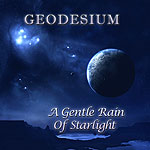 Of course, the music complements and completes the scene. We got our start with planetarium music, and with Seasonal STARGAZING, you'll provide your audiences with some of the newest, freshest sounding Geodesium music ever, much of it created in 2006. You'll find it on the Geodesium album A Gentle Rain Of Starlight.
Of course, the music complements and completes the scene. We got our start with planetarium music, and with Seasonal STARGAZING, you'll provide your audiences with some of the newest, freshest sounding Geodesium music ever, much of it created in 2006. You'll find it on the Geodesium album A Gentle Rain Of Starlight.
Great Star Shows... Done Right!
These are star shows done the way we've always dreamed about: with great voices; spot-on accurate pointer cues, and really LEARNING stars and constellations with eyes and ears. We hope you, your show presenters, and most importantly, your audiences enjoy them for years to come!
For what latitude are these shows? Why?
For Seasonal STARGAZING we have set our latitude at 40 degrees north. Quite simply, that's pretty much where most of the world's planetarium-going population is (and hence our potential market). A lot of what we talk about in the shows is featured very prominently in the seasonal sky, and visible from latitudes well above and below 40°. We tried to avoid things too near the horizon; about the only concerns might be the positions of Scorpius and Sagittarius in summer and the Big Dipper in autumn. For most theaters, they'll be fine.
What times are the skies set for?
We chose the dates smack dab in the middle of each season — specifically, February, May, August and November 1st — a couple of hours after sunset. It's like bowling; you aim down the middle and hope you hit most of them!
Can we show these in our tilted-dome theater?
You can, but our horizon is level, so the whole sky will be tilted the same angle as your dome. That's probably the way you do "what's up tonight" star talks anyway!
Can I just buy one season? One voice? Just the short ones? Just the long ones?
You get them all as part of the package; they're already all on the discs. You have maximum flexibility. Which ones you choose to play is up to you.
Are you planning to do Seasonal STARGAZING for the southern hemisphere?
We are always happy to accept commissions for such things! Contact us and maybe we can work something out!
We'd like to have these shows translated into our language. How can we do that?
SHORT ANSWER: "Anything is possible, given the right amount of time, money and people."
LONGER ANSWER: Unlike our other fulldome shows, Seasonal STARGAZING has English text appearing onscreen throughout the shows, so it's not just a matter of translating the script and substituting new soundtracks with our existing video. Each label for every constellation, star name, and deep-sky object would also need to be recreated and substituted for the English text in our video compositing program, then new video re-rendered.
Also, the timing of all the onscreen animations (the words appearing, the circling of stars, etc.) needs to align precisely with the script. For example, one can't spell out the name of a star onscreen at the start of a sentence if the actual name isn't heard until the end of the sentence; they have to be seen and heard simultaneously. It's a virtual certainty that a translated text will not match precisely with the original animations that were timed for the English language soundtrack. So we would have to re-time, re-program, and re-render every version of every show.
This is all eminently do-able, but a major amount of work. See the SHORT ANSWER. Please contact us for details.
Are you going to make these available for non-fulldome theaters? Couldn't I just use the soundtrack?
No. This style of production — with its precision timing and animation of lines and names — is just not practical to attempt in the classic slide-based planetarium medium.
Let's put it another way: speaking as producers who grew up giving classic planetarium green-arrow shows, it's only now with the development of the fulldome medium that we can finally give constellation talks the way we've always wanted to, but couldn't before, because of the limits of the technology. "Free at last, free at last...!"
Why didn't you include Perseus (or Draco or Virgo or Libra or Cetus or Cepheus or Ophiuchus or Antlia or...)?
We had to leave something for the sequel.
Can I use these in my PowerPoint presentations?
No.
Why the H. A Rey outlines? Why not your gorgeous Star*Lines?
In his books The Stars: A New Way To See Them and Find The Constellations, H. A. Rey created some of the most sensible constellation outlines for beginners we've ever seen. They're the ones we grew up with, and we've always wanted to see them used in a planetarium setting. We prefer them when teaching people constellations; that's why we chose them for the fulldome version of Sky Quest (and had our astronomer reading Find The Constellations in the video).
The Star*Lines for Digital Theaters are indeed very nice looking, and make a fine tool for shows that feature mythology or other classical symbology.
Which Geodesium album does this music come from?
 The music in our Seasonal STARGAZING shows is all new music, recorded in 2006. You'll find it on the Geodesium album A Gentle Rain Of Starlight.
The music in our Seasonal STARGAZING shows is all new music, recorded in 2006. You'll find it on the Geodesium album A Gentle Rain Of Starlight.
Can I replace your stars with mine?
No. These are rendered, fulldome movies, with stars already in place.
What is the air-speed velocity of an unladen swallow?
What do you mean? An African or European swallow?
Can I cut up your show to make it shorter?
No. You ask that about every show we have. What, 7 minutes is too long for your audiences?
For local appeal, I want to use my own panoramas in place of yours, so why can't I?
These shows aren't like the slide-based show kits of yesteryear, which relied on pieces and parts provided by planetarians. These are rendered fulldome movies; either they play or they don't. So our generic city/country pans are already in place; they can't be changed by the end-user.
Besides, we want people to concentrate on the stars above, not what's below them. The pans are simply visual cues that help the viewer understand which season we're presenting.
I can't see Alcor and Mizar as separate stars on my projector; all I see is a blob of pixels. What's wrong with your starfield?
Nothing, really; it's the low resolution that's the limiting factor.
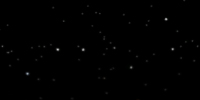
Here's the Big Dipper, actual size, clipped from our country sky at 1024 resolution. There's only so much one can do with 9 pixels.
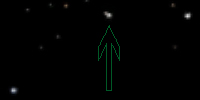
At 3200 resolution, we have at least a few more pixels to work with!
At 768, 1024, or even 1280 pixel resolution for a dome master of the sky, there's basically only a 3x3 block of pixels to display 2 points of light, one brighter than the other. So we're left with one pixel for Alcor, and four for Mizar. If we increase the resolution, we can do better.
Alcor and Mizar are hard to separate even on lower-resolution opto-mechanical projectors too. But that hasn't stopped planetarians from pointing out those stars before, has it? Nope. And it doesn't now. It's long been said that "the planetarium sky doesn't look like the real night sky" anyway. The point here is to tell audience members to look at the bend of the Big Dipper's handle for a double star. They should remember that when they go outside to try it on their own, regardless of what they see projected inside on your dome.
We've run your More Than Meets The Eye show for many years. Is this one similar to that?
Actually, Seasonal STARGAZING is a direct descendent of our long-time planetarium favorite. They both start with basically the same encouraging words:
"Stargazing — just looking at the night sky — it's an activity anyone with a curiosity about the heavens can enjoy. Step outside on a clear, dark evening and you can see thousands of stars. Many nights, the Moon brightens the sky... and sometimes you can find a planet or two shining among the stars. There are other stellar treasures out there, if you know where to look."
But don't take our word for it. Just check out the demo to hear the new version!
Roger Thompson, who narrated the original More Than Meets The Eye and HUBBLE Vision, is back in this new incarnation, so he'll sound familiar. And so will Wren Ross, who narrated HUBBLE Vision 2.
Rather than cover all four seasons as we did in More Than Meets The Eye, there's just one per show in Seasonal STARGAZING — and no telescope views this time around; just stars and constellations. But, otherwise, you get the same friendly tone as before, fine script writing by Carolyn Collins Petersen, great music by Geodesium, and topnotch artwork by Tim Kuzniar. It's all now brought up to date with modern animated graphics and fulldome video. Add to that the versatility of choosing either MINI or FULL shows, and you have More Than Meets the Eye done one better!
What about the Moon and planets? They're always moving around, so how can they be depicted in fulldome videos like this and still be accurately placed?
We agonized about this in the early production stages, and never did come up with a workable solution. Ultimately we decided to just mention them in passing at the start of the show. We say:
"Many nights, the Moon brightens the sky... and sometimes you can find a planet or two shining among the stars."
Then, to illustrate the points, we bring up the Moon for a few seconds to show its glow brightening the sky, along with a couple of planets in generic positions along the ecliptic.
To accurately demonstrate where the Moon and planets are tonight, we suggest that you use your planetarium's own software to set up your current night sky display, and give a little live presentation after our video.
Nigglers note: For spring and summer, when the ecliptic crosses low in the southern sky, in order to see planets and a waxing gibbous Moon a couple of hours after sunset, we had to skooch them off the ecliptic a few degrees so they wouldn't get cut off by the 270° truncated fisheye displays of some fulldome projection systems. Since our use is illustrative (they're only up for a few seconds), and the ecliptic is behind the audience (they're facing north at the time), we figure most people won't have a problem with this compromise forced on us by horizon cutoffs. If someone complains, you can compliment them on their knowledge of celestial mechanics. Then ask them to point out Antlia.
Select link to preview the trailer.
Shows from Loch Ness Productions come with English language soundtracks standard. Translated soundtracks are provided as additional items, not substitutes for the English ones. If your show's movies contain multiplexed audio, you'll receive separate movie files for each language.
Don't see the language you want? Let's work together to create it. Read more here!



